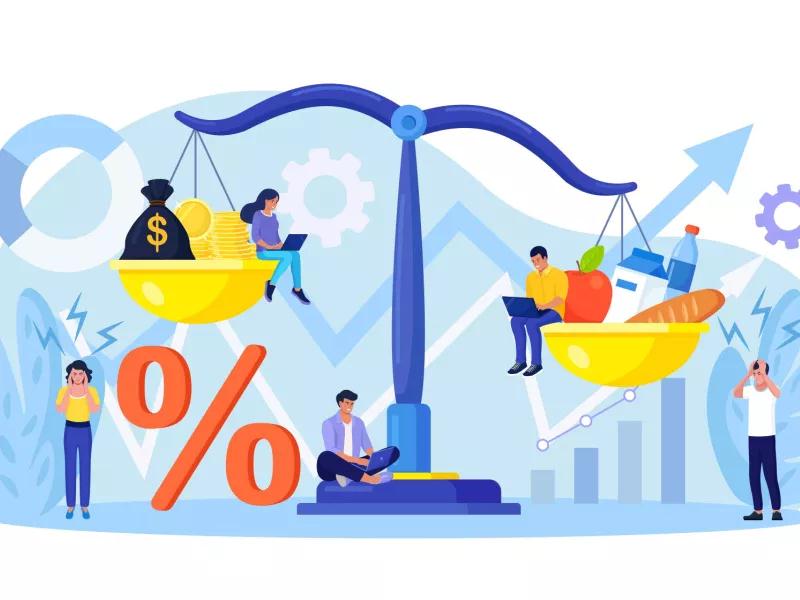We all have a more or less clear idea of what GDP is, the gross domestic product, that is, the production of goods and services of a nation measured in dollars or local currency, we call this nominal GDP. However, there are other indices that can give a more precise look at the development of a national economy, one of these is the PPP GDP (or Gross Domestic Product by purchasing power parity.
The PPP GDP is the measurement that allows us to measure the gross domestic product of a nation, eliminating the price differences that exist between each country. For example: If I produce 4000 dollars of income in the United States, I will be able to buy certain things with that, but if I earned 100 dollars in Rwanda, I will be able to buy many more things, so my purchasing power will be greater with 4000 dollars in Rwanda than with 4000 dollars in the United States.
Then PPP GDP would be the result of a country’s production of goods, rather than money. To calculate PPP GDP, the prices of goods and services in the United States, the world’s largest economy by nominal GDP, are used as a reference.
To understand the concept of GDP by purchasing power parity a little more, it is necessary to understand this last reference: Purchasing power parity. In this section we will address this concept:
Purchasing power parity
Macroeconomic analysis relies on several different metrics to compare economic productivity and living standards across countries and over time. A popular metric is purchasing power parity (PPP).
Purchasing power parity (PPP) is an economic theory that compares the currencies of different countries through a “basket of goods” approach . According to this concept, two currencies are in balance or at par when a basket of goods (taking into account the exchange rate) has the same price in both countries . Closely related to purchasing power parity is the law of one price, which is an economic theory that predicts that after accounting for differences in interest rates and exchange rates, the cost of something in country X should be the same as in country Y in real terms.
How to Calculate Purchasing Power Parity
The relative version of purchasing power parity is calculated with the following formula:
Where: S = P1/ P2
S represents the exchange rate from currency 1 to currency 2
P1 represents the cost of good X in currency 1
P2 represents the cost of good X in currency 2
How purchasing power parity is used
To make a price comparison between countries that has any kind of meaning, a wide range of goods and services must be considered.
The amount of data that must be collected and the complexity of drawing comparisons make this process difficult.
To facilitate this, the International Comparisons Program (ICP) was established in 1968 by the University of Pennsylvania and the United Nations. The purchasing power parities generated by the ICP are based on a global price survey that compares the prices of hundreds of various products. These data, in turn, help international macroeconomists construct estimates of global productivity and growth.
Every three years, the World Bank produces and publishes a report that compares various countries in terms of PPP and US dollars. Both the International Monetary Fund (IMF) and the Organization for Economic Cooperation and Development (OECD) use weights based on Purchasing Power Parity metrics to make predictions and recommend economic policies. These actions often impact financial markets in the short term.
Some Forex traders also use the purchasing power parity measure to find potentially overvalued or undervalued currencies. Investors who own stocks or bonds of foreign companies can evaluate Purchasing Power Parity figures to predict the impact of exchange rate fluctuations on a country’s economy.
PPP: the alternative to market exchange rates
The use of purchasing power parity is the alternative to using market exchange rates. The real purchasing power of any currency is the amount of that currency needed to purchase a specific unit of a good or a basket of common goods and services. Purchasing power is determined in each country based on its relative cost of living and inflation rates. Purchasing power plus parity equalizes the purchasing power of two different currencies by taking into account differences in inflation rates and the cost of living.
The Big Mac index: an example of PPP
As a light-hearted annual test of purchasing power parity, The Economist has tracked the price of McDonald’s Corp.’s (MCD) Big Mac hamburger in many countries since 1986. The much-publicized Big Mac index measures purchasing power parity (PPP). ) between nations using the price of a Big Mac as a reference point. The Big Mac index suggests, in theory, that changes in exchange rates between currencies should affect the price consumers pay for a Big Mac in a particular nation, replacing the “basket” with the famous burger. This is an excellent example of how the “law” of one price fails in practice.
For example, if the price of a Big Mac is $4.00 in the US and £2.5 in Britain, we would expect the exchange rate to be 1.60 (4/2.5 = 1.60). If the dollar to pound exchange rate is higher, the Big Mac index would indicate that the pound was overvalued, lower, and would be undervalued.
That said, the index has its flaws. First, the Big Mac price is decided by McDonald’s Corp., which can significantly affect the Big Mac index. Additionally, the Big Mac differs around the world in size, ingredients, and availability. That said, the index is intended to be distinctive and is a great example used by many schools and universities to teach students about purchasing power parity.
GDP and purchasing power parity
In contemporary macroeconomics, gross domestic product (GDP) refers to the total monetary value of goods and services produced within a country. Nominal GDP calculates monetary value in current and absolute terms. Real GDP takes nominal GDP and adjusts it for inflation. Additionally, some GDP accounts are PPP adjusted. This adjustment attempts to convert nominal GDP into a more easily comparable number between countries with different currencies.
One way to think about what PPP GDP represents is to imagine Japan’s total collective purchasing power if it were used to make the same purchases in US markets. This only works after all yen are exchanged for dollars. Otherwise the comparison is meaningless.
The following example illustrates this point. Let’s say it costs USD 10 to buy a shirt in the US and it costs €8 to buy the same shirt in Germany. To make an apples-to-apples comparison, the €8.00 in Germany must be converted to US dollars. If the exchange rate were such that the t-shirt in Germany costs USD 15.00, the PPP would be a ratio of 15/10, or 1.5. For every $1.00 spent on the shirt in the US, it takes $1.50 to get the same shirt in Germany.
Which nations have the greatest purchasing power?
The five nations with the highest GDP in terms of market exchange are the United States, China, India, Japan and Germany. This comparison changes when using PPP According to 2017 data from the International Monetary Fund (IMF), China has overtaken the US as the world’s largest economy based on purchasing power at 23.122 billion current international dollars . The United States is in second place with 19,362 million dollars. They are followed by India, Japan and Germany with 9,447 million, 5,405 million and 4,150 million, respectively.
How to calculate PPP GDP
To calculate PPP GDP we take the goods of a nation as a whole and measure them according to the prices that these goods have in the United States. It would be something like taking all of China’s production to the United States and putting it at American prices.
This phenomenon of variation in prices occurs because nations have different currencies with speculative appreciations and also with different levels of inflation and demand for consumer goods.
According to this indicator we can safely say that today China is the first economy in the world by GDP PPP, since its gross domestic product by purchasing power parity is 27.3 trillion dollars, which in real terms means that China is producing more goods than the United States, whose PPP GDP is 21.4 trillion dollars.
As we had previously stated, having a dollar in the United States is not the same as having a dollar in Rwanda. With a dollar in Rwanda you buy many more things than with a dollar in the United States.
By measuring GDP by purchasing power parity we can have a clearer idea of the real size of an economy, since this indicator tells us how big the real economy of a country is and not only tells us the prices that are paid in nominal terms. currently for his assets.
How are Latin American countries in the GDP ranking by purchasing power parity?
Latin American countries have been developing more and more during the last decades, mainly due to high investments in raw materials, the expansion of services and tourism, which has led their economies to grow both in their nominal GDP and in its PPP GDP.
In terms of the ranking, the main Latin American economies have the following PPP GDP:
Brazil, with 3.2 trillion dollars, is the eighth largest economy in the world.
Mexico: 2.3 trillion dollars. 12th place.
Argentina: 0.9 trillion dollars. Rank 26
Colombia: 0.7 trillion dollars. Position 30.
Chile: 0.4 trillion dollars. Position 43.
Peru: 0.4 trillion dollars. Position 44.
Source: World Bank.
Conclusions
PPP GDP gives us a better idea of the real size of economies. However, it still does not tell us much about the state of well-being of the citizens living in each country. For this it would be good to take into account the GDP per capita by purchasing power parity. and the human development index, these two indicators help us understand what the economy of the people in a given nation is like and how high their level of well-being is.











